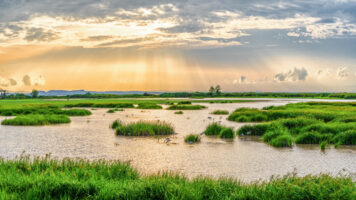WETLANDS AND THEIR ROLE IN WATER QUALITY IMPROVEMENT
Wetlands and Their Role in Water Quality Improvement
Wetlands, often referred to as nature’s kidneys, play a crucial role in improving water quality. These unique ecosystems serve as natural filters, reducing pollution and providing a range of ecological services. As we face growing concerns about water pollution and the need for sustainable water management, understanding the role of wetlands in water quality improvement is of paramount importance.
What Are Wetlands?
Wetlands are transitional areas where water meets land. They come in various forms, including swamps, marshes, bogs, and fens. These ecosystems are characterized by waterlogged soils and the presence of specific plant species adapted to living in waterlogged conditions. Wetlands are often found at the confluence of rivers, in low-lying areas, and along coastlines.
Natural Filtration Systems
One of the most significant contributions of wetlands to water quality improvement is their capacity to filter and purify water. Wetland vegetation and the intricate network of root systems act as natural filters. When water flows through a wetland, sediments, pollutants, and excess nutrients are trapped and removed. This process significantly enhances water quality.
Nutrient Removal
Wetlands are particularly effective in removing excess nutrients, such as nitrogen and phosphorus, from water. These nutrients are often introduced into water bodies through agricultural runoff, sewage discharges, and industrial processes. Elevated levels of nutrients can lead to water quality problems, such as algal blooms and oxygen depletion. Wetlands help mitigate these issues by absorbing and retaining excess nutrients.
Pollution Abatement
Wetlands also function as pollution abatement systems. They can filter out various pollutants, including heavy metals, organic contaminants, and pathogens. As water passes through wetlands, these pollutants are immobilized and broken down by microbial communities, rendering the water cleaner and safer for aquatic life and human consumption.
Habitat for Biodiversity
Beyond their water-cleaning capabilities, wetlands support diverse ecosystems. They provide critical habitat for a wide range of plant and animal species. This biodiversity contributes to ecological balance and resilience, which is vital for overall ecosystem health.
Flood Mitigation
Wetlands act as natural sponges, absorbing excess water during heavy rainfall or flooding events. By doing so, they reduce the risk of downstream flooding. This flood mitigation role not only protects human communities but also helps prevent erosion and sedimentation in water bodies, further enhancing water quality.
Recreational and Aesthetic Value
Wetlands offer aesthetic and recreational benefits, making them important for human well-being. They provide opportunities for birdwatching, fishing, and hiking, while their serene landscapes offer relaxation and a connection to nature.
Preservation and Restoration
Unfortunately, wetlands are under threat due to urban development, agriculture, and land use changes. Efforts are being made worldwide to preserve and restore these vital ecosystems. Government regulations and conservation initiatives aim to protect existing wetlands and restore those that have been degraded.
Wetlands are unsung heroes in the quest for improved water quality. Their natural filtration systems, nutrient removal capabilities, pollution abatement functions, and overall ecological significance make them invaluable resources. Recognizing the importance of wetlands and taking steps to protect and restore them is a vital component of sustainable water management and environmental conservation. As we face mounting challenges related to water quality and ecological balance, the preservation and restoration of wetlands must remain a top priority.
Cons:
- Weight: Concrete is much heavier than steel, requiring robust foundation systems and often limiting its use in high-rise structures.
- Cracking: Concrete can develop cracks over time, potentially leading to structural issues if not properly maintained.
- Curing Time: Concrete takes time to cure and gain its full strength, which can delay construction schedules.
- Environmental Impact: The production of cement, a key component of concrete, is associated with a significant carbon footprint.
In conclusion, the choice between steel and concrete in building design depends on various factors, including budget, structural requirements, aesthetics, and environmental considerations. Steel offers exceptional strength and design flexibility but comes at a higher cost, while concrete is cost-effective, durable, and versatile in design but can be heavy and may require more extensive maintenance. It is essential to weigh the pros and cons of each material carefully and work with experienced professionals to make the best choice for your specific project.


